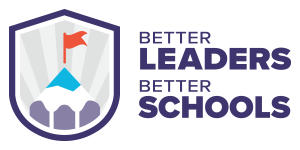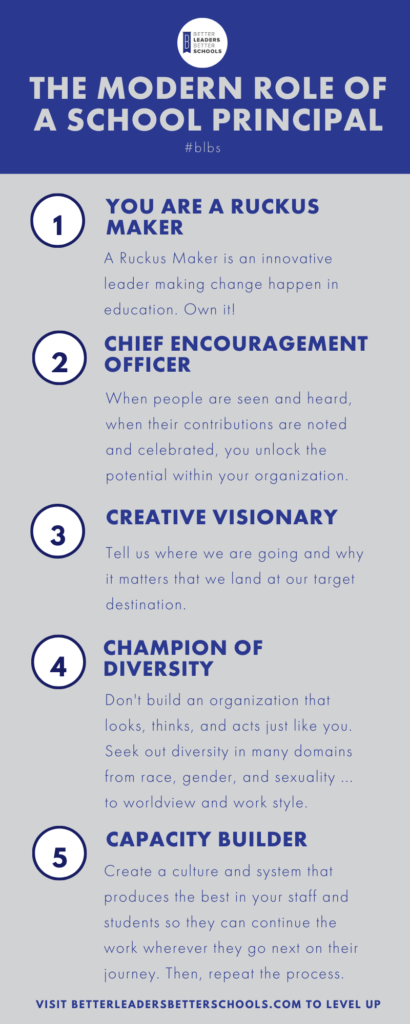This post is designed to take a fresh and innovative look at the role of a school principal. You might even say it’s an uncommon approach to the role, but that’s what we do at Better Leaders Better Schools.
A traditional approach to the principalship will get you the same results, but that’s not why you are here.
Einstein said that insanity is doing the same thing yet expecting different results.
You want to be different. Better. So you challenge tradition if you want to level up education.
I love the imagery of the ripple effect. A stone dropped into water continues to make waves long after the initial action is gone. What is the wave you want to intentionally create? How can you do that in your role as a principal?
What if you realized that your role was to be a catalyst. The fact is, change is happening within your organization. Your presence accelerates that change and it’s up to you if it’s in either a positive or negative direction.
That said, here is a modern take on your role.
It’s meant to get you to think about serving as a school leader in an out-of-the-box fashion. If you get value you from what you read today, please share on social media. I also created an infographic that synthesizes the main points of today’s post as well for you to download.
The role of a school principal in 5 parts
#1: You are a Ruckus Maker
I call members of our community, Ruckus Makers.
This means that you are an innovative leader making change happen in education. You don’t do things the ways they have always been done because there is value in iterating and making things better.
Better might mean you eliminate things you are doing that no longer serve your community.
Or better might look like taking a leap of faith and protecting those already innovating.
Sometimes you can get there in just two words, like “What If?”
However you decide to make change happen, own it. Your community needs your leadership. Go make a ruckus!
CLICK HERE TO READ WHAT A PRINCIPAL IS AND WHAT A PRINCIPAL IS NOT
#2: You are a Chief Encouragement Officer
Culture is everything and cultures do not thrive without great effort and intention. Leaders I coach have loved both The Happiness Advantage and The Culture Code when they consider building the school of their dreams.
An integral part of a thriving culture is acknowledgment and connection.
Three questions that everyone on your staff is asking themselves daily:
- Am I doing a good job?
- Does my work matter?
- Is my work appreciated?
Effective feedback is crucial here. Staff appreciation also matters.
And my best tip you can take action on is to do a bucket list with your staff.
Seriously.
If you have the courage to get to know your colleagues on a personal level and take action making their dreams come true, I promise you will build a remarkable school.
There is nothing more encouraging than being seen and heard, which is another way of saying “being fully known.” If your staff believes that you care about them as individuals, they will work hard to make your vision for the school come true.
If you help them realize their dreams, they will help you realize yours.
Reciprocity, connection, and empathy are beautiful things.
CLICK HERE TO READ 200 TIPS FOR SCHOOL LEADERS
#3: You are a Creative Visionary
I love sharing this quote by Seneca:
“If one does not know to which port one is sailing, no wind is favorable”
As a leader, you must set the course.
One of your most important roles of a school principal is setting the vision. Without it, you can have 50 people rowing in 50 different directions.
Talk about frustrating!
If you are dissatisfied with any aspect of your school, the culprit very well can be a lack of a clear and compelling vision. In reality, this is the most commonly overlooked aspect of a principal’s role.
Many schools have an unimpressive vision statement. Not only are they generic, but they are also uninspiring.
Working in education gives leaders a distinct advantage to leverage. The work is inherently meaningful. Tap into that.
“Shoot for the moon. Even if you miss, you’ll land among the stars.”
― Norman Vincent Peale
If you love this graphic share it on social media!
[bctt tweet=”The Modern Role of a Principal: https://betterleadersbetterschools.com/what-is-the-role-of-a-school-principal – Better Leaders Better Schools @alienearbud #blbs #RuckusMaker #education”]
#4: You are a Champion of Diversity
Diversity has always mattered, but the murder of George Floyd really has awakened white consciousness on this issue across the globe. I can’t say all consciousness because people of color are always aware of racism. It is a point of privilege for whites to forget that it exists.
Yes, race matters in terms of diversity, but consider a variety of aspects: gender, sexual orientation, body size, faith, gender identity, etc.
You can also think of diversity in terms of worldviews, how people make decisions, and the different strengths they bring to the table.
Not only can you upgrade your school by reviewing your curriculum, collectively you can level up by making the right hiring decisions. The default is to hire people that look, think, and act like you. This is a mistake. We falsely believe that we are hiring for a cultural fit, but in reality, we are hiring because of unconscious biases we all have.
Investigate all your hires and get curious about why you easily pass on some applicants. They must just have a different way of thinking that is desperately needed to make your team better.
CLICK HERE TO ACCESS AN ANTIRACIST PODCAST PLAYLIST
#5: You are a Capacity Builder
Build your people. Don’t worry if they get so good they will leave because of increased opportunity. You should be proud of that.
If you’re worried about losing your people because of developing them, think about it in the inverse. What is the cost of not developing your people and retaining them?
Whether it is staff or students, the best leaders look for ways that their people can stretch and grow. You can do that simply by asking how they would like to grow. Inevitably some will respond, “I don’t know.” As a leader, there is tremendous power in calling out the gifts we notice in people. A simple, “I really like how you do ‘X’ will you help lead this initiative?” is a powerful tactic.
This works for both staff and students.
It’s magic when you get your students involved in leading campus initiatives. And when you build the capacity of those you serve, don’t look solely at your stars. You’ll miss opportunities to unlock the potential within your organization if you only stick with A-players and A-students. Bring all sorts of students and staff into leadership opportunities.
Case in point: one of the worst academically performing students I have ever taught was also the best senior rally emcee I have ever witnessed. He didn’t fit the traditional school model, but he thrived as an entertainer and story-teller. If I only looked at my top-performing students to lead the senior rally we all would have missed out. He held the attention of 900 staff and students in the palm of his hand.
Your people’s capacity matters, but don’t forget about yourself!
Developing your own capacity includes:
- Building your mental models
- Making better decisions
- And reading a lot, especially books outside education.
IF YOU’D LIKE TO SUPERCHARGE YOUR LEADERSHIP DEVELOPMENT — CONSIDER JOINING THE MASTERMIND




